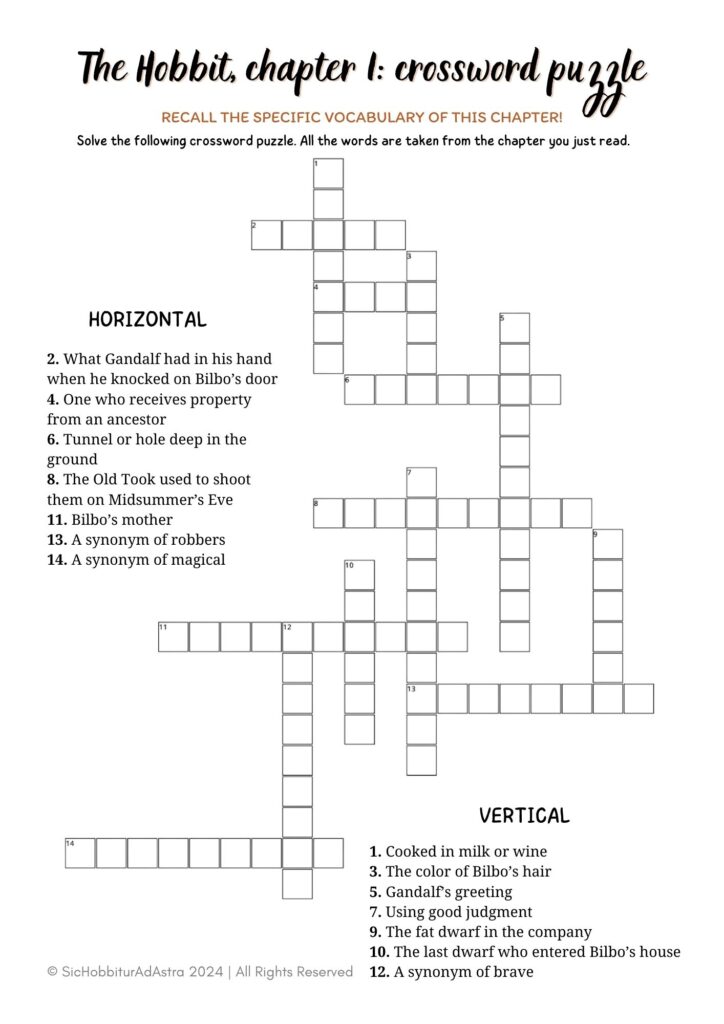
Thinking about diving into “The Hobbit” with your middle school students? Great choice! This novel is perfect for kids this age, eager for adventure, friendship, and growth. It’s bound to be a meaningful journey!
This book is also packed with ideas for engaging classroom activities. You’ll find plenty to fit your style and your students’ needs.
If, like me, you often don’t have much time to prep, or if you’re just looking for a solid starting point, this post is for you!
I’ll outline my step-by-step approach, complete with practical examples. It’s a proven method I use with other books too, and it’s comprehensive and enriching.
- FIRST STEP: INTRODUCING THE READING AND STRUCTURING LESSONS
- SECOND STEP: ANALYSIS WORKSHEETS
- THIRD STEP: HOMEWORK AND NOTEBOOK ORGANIZATION
- FOURTH STEP: DISCUSSIONS AND FEEDBACK
- FIFTH STEP: FINAL TEST
- BONUS: FUN AND CREATIVE ACTIVITIES
FIRST STEP: INTRODUCING THE READING AND STRUCTURING LESSONS
“The Hobbit” deserves a slow read, allowing students to savor the story and absorb its themes. Here’s how I organize the lessons:
- Read one chapter a week with your students. With 19 chapters, this will take about 4-5 months.
- Set aside two hours each week for the book. In the first hour, focus on homework review, quizzes on the previous chapter, and class discussions (in the first week, introduce the book and the author). In the second hour, read the new chapter together.
- Use structured tools to guide reading, helping students ask questions and find key information. I provide detailed worksheets that focus on comprehension, speaking, and writing skills, useful both in class and at home.
- Mix in fun, creative activities like crossword puzzles for vocabulary reinforcement or creative writing assignments.
- Wrap up with a final test that sums up everything learned.
Let’s get into the details! Check out the example worksheet for Chapter 11 that I’ve attached. You can download it here:
SECOND STEP: ANALYSIS WORKSHEETS
“The Hobbit” is rich in meaning and offers various levels of interpretation. I organize the analysis worksheets into four sections:
- COMPREHENSION: Simple questions about the plot that I read aloud before starting. Students keep this handy during reading to stay focused and enhance comprehension skills.
- VOCABULARY: Focuses on specific terms and literary devices. Students complete this at home using a dictionary if needed.
- INTERPRETATION: Encourages deeper reflection, helping students identify cause-effect relationships, character psychology, and more. Assigned as homework for the next lesson.
- ENGAGEMENT: Personal reflection exercises that connect themes from the book to students’ experiences. This is assigned for the next lesson and helps students internalize their learning.
All these sections are part of my bundle on Teachers Pay Teachers: 19 comprehensive worksheets, one for each chapter, with solutions! If interested, check the link at the end.
THIRD STEP: HOMEWORK AND NOTEBOOK ORGANIZATION
As mentioned, part of the worksheet is homework. It’s crucial for students to revisit the chapter, each at their own pace, to fully understand and creatively interpret the content.
I recommend being strict about this section: homework should be complete and organized in a dedicated notebook to build a cohesive learning path. This will be essential for the final test preparation.
FOURTH STEP: DISCUSSIONS AND FEEDBACK
I suggested spending part of the lesson on homework review. This is a great way to assess understanding.
I also recommend calling on one or two students to discuss the previous chapter. Using the worksheet structure for questions helps, and it keeps students motivated to complete their homework carefully. Plus, they feel more at ease since they know the topics in advance. It’s a win-win!
Remember, this isn’t about turning homework review into a formal interrogation. This is the most rewarding part—where students share their perspectives and engage in lively discussions. Focus on a few students while involving everyone in the conversation.
FIFTH STEP: FINAL TEST
At the end of this project, I usually give a test: it’s not only about checking reading and comprehension but also about personal reflection on the book’s themes. You’ll find a detailed test in my TPT resource with various question types.
BONUS: FUN AND CREATIVE ACTIVITIES
To make things even more engaging, I love incorporating fun activities. Crosswords for vocabulary are always a hit! Sometimes, I replace vocabulary exercises with a crossword or hold a team tournament with prizes!
Other great activities include writing letters to characters or doing character reviews. The more variety, the better!
All this and more is in my TPT bundle. Check it out if you’re interested!
How do you work with your students on texts? Share your thoughts in the comments—I’d love to hear from you!
Still unsure if this novel is right for you? Check out my article on why it’s a great choice for students!
Thank you for stopping by!
Happy teaching!
Chiara


